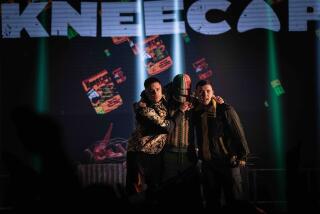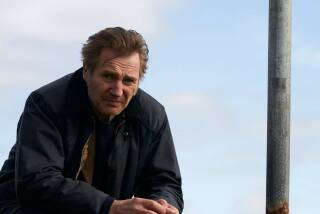Roads paved in myth, magic
DUBLIN, IRELAND — We careened through the hectic maze of a traffic circle and spun off onto a seemingly quiet side road. A yellow-and-blue double-decker bus, its horn blaring, thundered toward us.
“What’s he doing on our side of the road?” I screamed to my friends.
“We’re on his side of the road,” one answered.
Could it be? The three of us had been in Ireland less than two hours and were about to be incinerated in a head-on collision. We swerved off the highway onto a dusty shoulder as the bus blew by.
St. Pat may have cast the snakes out of Ireland, but he didn’t do anything to improve highway safety. The country is bedeviled by road hazards and hindrances, which include driving on the left side of the road, which stupefies many Americans. Then there are those cursed roundabouts (a.k.a. traffic circles) and those maniacal Irish drivers.
It’s enough to make you feel as though you’ve been catapulted onto Mr. Toad’s Wild Ride. Or, as Phoenix tourist Liz Kirchgatter put it: “Driving here? Mercy, now that’s a challenge.”
But the payoff is Ireland itself, a magical place where the journey takes visitors along spectacular coastlines, through wild glens and to small towns overflowing with character -- and characters. The best way that I have found to see it is by traveling the Emerald Isle’s crazy highways and byways.
Another plus: An Irish road trip is an economical way to go. Weeklong packages, with round-trip airfare from LAX, car rental and bed-and-breakfast lodgings, start as low as $855 a person, double occupancy, in the fall and winter off-season (August high-season rates are $1,350 per person). And you can choose from hundreds of bed-and-breakfast inns that annually put out the welcome mat. They offer a night’s lodging, huge breakfasts, companionship, advice, driving tips and a glimpse of Irish hospitality at its best, all for less than $50 a person a night.
Two friends and I sampled that hospitality on a weeklong driving trip last fall that we booked from Sceptre Tours (see “Planning This Trip” box). Our itinerary took us from Dublin to Northern Ireland and then on a counterclockwise tour of the Emerald Isle; we hoped to see some of the major highlights along the route and visit some pubs.
We hadn’t expected the white-knuckle twists and turns as we drove through the Irish Republic and Northern Ireland. At times, we felt as though we were sitting on the inside pole in a NASCAR race, but the experience was worth the thrills and chills.
Driven to near-tears
We weren’t so sure about that, however, the afternoon we left the rental car facility outside Dublin International Airport and nearly became road kill.
It was our fault, of course; we were typical American tourists. We’d been confident we could handle any driving dilemma Ireland put in our path. But driving on the left wasn’t the only issue. Everything in the car seemed backward -- turn signals, wiper blade controls and headlight switches.
As semis, vans and cars whizzed by, we found ourselves wishing we were ensconced on a giant Gray Line tour bus piloted by an Irish driver.
After the near-debacle with the bus, we hit a low point as we sat hyperventilating on the shoulder. A group of highway workers blocked traffic while we turned the car around as the crew foreman explained, “They’re Americans. Just go around them.”
The drivers smiled or nodded and dutifully steered their cars around us. I doubt the response would have been the same if we had caused a similar problem on Pacific Coast Highway.
We were trying to find our way to the motorway, an interstate-like divided highway that would take us to Northern Ireland. We’d been told the drive to Browns Country House, a bed-and-breakfast north of Belfast near the North Channel seacoast, would take about three hours. But we got lost so often it took six.
We tumbled into Browns after dark in a driving rain. Several people had warned us not to drive at night or in the rain. Good advice. It’s hard enough to find your way around under perfect conditions. Many roads don’t have signs; others have so many signs you can’t tell which way to go. Then there are the lights. At some intersections, both red and green lights are illuminated at the same time.
Our GPS seemed as confused as we. When we made a wrong turn, it repeated, “Recalculating. Recalculating.” Then it would really get wacky and say “Impossible. Impossible” in a clipped British voice that seemed on the brink of a breakdown.
We felt the same way after a 10-hour flight across a continent and an ocean, topped by six hours of tense driving.
But Jean Brown’s country house took the edge off. The good Mrs. Brown had tea and coffee waiting, directed us to comfy rooms with private baths and invited us to join other guests in the sitting room for what she promised would be “spirited conversation.”
We asked directions to the closest pub instead.
In less than an hour, we were quaffing Guinness and savoring aged, peppered fillet of beef flamed in Irish whiskey in the dining room of the Bushmills Inn, a quaint re-creation of an old coach inn and mill house. For dessert, we soothed our stressed psyches with sticky toffee pudding, a restaurant specialty.
The inn, along with Bushmills Distillery, are focal points of the charming village of Bushmills. The next day we returned to tour the manufacturing plant, Old Bushmills, which opened its doors in 1608. It’s the only working Irish whiskey distillery open for tours; it’s also the first recorded whiskey distillery.
Early the next morning, I explored the bucolic grounds of Browns Country House. Sheep and cows grazed nearby, and wild blackberries grew everywhere on the 1-acre property.
The dining room was my next stop. I couldn’t wait to try the fabled full Irish breakfast. Eggs, two types of sausage, ham, tomatoes, toast, juice, coffee, tea. I wouldn’t need lunch. And Sam Brown, Jean’s husband, seemed a natural entertainer in the lovable-Irish-rogue vein. He told joke after joke, many of them slightly racy.
The other B&B; guests, including two couples from Toronto and two Irishwomen, had gathered in the dining room, laughing at -- and with -- Sam.
I asked about the sausage, then wished I hadn’t. The darker version, I was told, is sometimes called blood sausage and is made from meat mixed with blood. One of the Irish guests volunteered that it’s usually made the day of slaughter when the blood is fresh.
I pushed away from the table.
“Anything wrong?” Sam asked.
“No, it’s just a bigger breakfast than I’m used to,” I answered, hoping I hadn’t turned green.
“You should try black and white pudding while you’re here,” the Irish guest added, saying it was a local favorite. “Black pudding is made with fresh pig’s blood; the white version uses minced liver.”
There were a lot of Irish dishes I wanted to try on this trip, but those weren’t among them.
Irish whiskey was, so we packed up and headed to Old Bushmills for a morning of sipping and savoring, then moved on to some sightseeing.
Among the nearby highlights were the Carrick-a-Rede Island Rope Bridge, a swaying, 60-foot-long rope-and-plank bridge that connects the island to the mainland; and the Giants Causeway, a lunar landscape on the seacoast of Northern Ireland that got its name from a legend about dueling behemoths.
I’m not sure I’m acrophobic, but I didn’t want to step out onto that rope bridge and find out, so we stuck with the Causeway, an awe-inspiring place with ominous gray cliffs, crashing surf and bizarre columns of basalt -- the result of volcanic action -- that plunge downward into the sea.
And then we were back on the road.
Ireland is about the size of Indiana, with Northern Ireland taking up about one-sixth of that area. Since the 1920s, when the largely Protestant north was officially partitioned from largely Catholic Ireland, it has been plagued by sectarian violence. But intense peacemaking efforts that began in the mid-’90s have finally smoothed the waters here.
The upside of wrong turns
The Irish countryside is green, fertile and crisscrossed by rivers and lakes. It was rare to pass someone on a two-lane road without a greeting of some kind, a smile or a wave.
Of course, that may have had something to do with the number of times we stopped to ask directions. Exploring Ireland is a trial-and-error process. And that’s not all bad.
“Every time we get lost, we find interesting things,” said traveler Dale Henderson of Alton, Ill. That happens a lot, he added. “We get lost everywhere we go. Many of the roads are walking paths, not real roads. But we’ve come to feel that if we get lost, it’s just that much more of an adventure.”
Detours are an ever-present part of that adventure, we learned. One day we spent several hours trapped in a gridlocked detour in the countryside. Eventually we worked our way to a police officer directing traffic. Because no one was moving, he had plenty of time to chat, so we asked about the delay and learned it was due to a double fatal accident.
“The Irish are bad drivers,” he said. “We had three fatals earlier today and now two here. Five in Ireland in one day.”
Statistics back up his concern, and place the blame on drunk drivers. A report published last fall by the European Road Safety Council criticized Ireland for its lenience regarding blood alcohol content.
We also asked the chatty officer about the best way to explore the country; we confessed that we had gotten lost several times and asked how we could avoid it. Did we need a better map?
“A map in Ireland? No. You stop and ask someone. You see a light on in a house, stop and ask.”
We mentioned our GPS. He laughed. “A GPS in Ireland? This isn’t America or England, you know.”
Our next B&B; stop was in Galway at Avoca House, a modest two-story family home. Proprietor Kathleen Laffey had warm scones and tea waiting when we pulled in long after dark. The rooms were small but comfortable, and the breakfast table overflowed.
We were eager to explore the narrow, winding streets of Galway, which turned out to be a great place to shop. Within a few hours, we had loaded up the rental car with sweaters, T-shirts, hats and other fun souvenirs.
We’d arranged our tour to include a one-night stay at a castle, an optional upgrade available with most package tours. (Another, very important upgrade is from a manual transmission car to an automatic. Don’t skimp with this one.)
Our castle, Adare Manor in County Limerick, was everything we could hope for. Adare Manor Hotel and Golf Resort was set amid 840 acres of formal gardens and rolling parkland, and its towers, turrets and ruins dated back more than 800 years.
The 18th century manor, once a private home, has 63 bedrooms, a spa and a Robert Trent Jones Sr. golf course. I spent the day pretending I was the lady of the manor.
The next day, we became commoners again, lodging at a B&B.; But that night’s stop was anything but common. Ballaghmore House, in the County Laois village of Borris-in-Ossory, was our favorite B&B.; Proprietor Carole England has added a health and well-being center, so we could have gotten a massage or other spa treatments if we’d had time.
Even without the frills, Ballaghmore was noteworthy. The dining room had an open-beam ceiling, giant bricked hearth and seating for 22. Breakfast started with a table full of pastries, cheeses and fruit. Then England handed us a menu with hot offerings: Eight were available that day. It was more like a short-order diner than a B&B.;
Of course, one of the offerings was the standard Irish breakfast. I ordered it.
But I asked her to hold the blood sausage.
--
--
(BEGIN TEXT OF INFOBOX)
10 tips for a less-loopy road trip
1. Think small car: Roads are narrow (lanes were created for horses, not cars), and there are rarely shoulders.
2. Upgrade: Package tours usually come with a manual transmission car. Learning to shift with your left hand, while driving on the left side of the road, is tough. Get an automatic.
3. Take the GPS too: It will make you crazy at times, but you need all the help you can get.
4. Take plastic: Gas is expensive. Most stations take Visa and MasterCard.
5. Feeling loopy? Roundabouts are ubiquitous. Take a few minutes to watch one in action. Yield to traffic coming from the right.
6. Don’t drive at night: It’s too easy to get lost.
7. Drive in dry weather: You’ll get wet asking directions when you get lost.
8. Ditch the car in Dublin: Traffic is fierce. Walk or take the bus.
9. Backroads are fun: Many travelers stay off the beaten path and explore rural areas, where traffic is less hectic and it’s easier to meet the gracious people of Ireland.
10. Be patient: The pace is different here. Slow down and enjoy it.
--
Rosemary McClure
--
Planning this trip
THE BEST WAY
From LAX, Aer Lingus offers nonstop service to Dublin, and British, Continental, Delta, US Airways, American and United offer connecting service (change of planes). Restricted round-trip fares begin at $382.
WHERE TO STAY
Many Ireland travel packages offer vouchers for stays at B&Bs; or other accommodations. You can choose an area in advance and be assigned to suitable lodgings; or you can wing it, and choose where you wish to stay as you go. Alternatively, you can contact B&Bs; directly to make reservations. I planned my trip through Sceptre Tours ([800] 221-0924, www.sceptretours.com), which specializes in Ireland and Scotland and offers inexpensive packages.
Browns Country House B&B;, 174 Ballybogy Road, Coleraine BT52 2LP, Northern Ireland; 011-44-28-2073-2777, www.brownscountry
house.co.uk. Eight rooms, all with bath. Near Giants Causeway and Old Bushmills Distillery. Doubles $49 to $51.
Adare Manor Hotel and Golf Course, Tadare, County Limerick, Ireland; (800) 462-3273 for reservations from the U.S., www.adaremanor .com. If you’ve always wanted to sleep in a castle, this is the place. Other amenities: 18-hole golf course, spa. Doubles from $392.
Ballaghmore Country House B&B;: Ballaghmore, Borris-in-Ossory, County Laois; 011-353-505-21366, www.ballaghmorecountry
hse.com. Large, comfortable, well-run home with spa treatments available. Also, self-catering units. Doubles $53 to $61.
Avoca House, 3 Merlin Gate, Geata Na Mara, Merlin Park, County Galway; 011-353-91-757-866, e-mail: [email protected]. Family home convenient to Galway city center. Doubles $61 to $99.
WHERE TO EAT
Bushmills Inn Hotel, 9 Dunluce Road, Bushmills, County Antrim BT57 8QG, Northern Ireland, 011-44-28-2073-3000, www.bushmillsinn.com. Nineteenth-century coach inn has a welcoming atmosphere, turf log fires and serves Irish specialties. Entrees $20 to $48.
Fiddlers Creek, Rockwood Parade, Sligo, County Sligo, Ireland, 011-353-71-914-1866, www.fiddlerscreek.ie. Waterside pub with cozy dining area and good food. Entrees average $26.
TO LEARN MORE
Tourism Ireland, (800) 223-6470, www.tourismireland.com.
--
On travel.latimes.com
To see more of Ireland’s roadside splendors on this driving trip, go to latimes.com/irelanddrive.
More to Read
Sign up for The Wild
We’ll help you find the best places to hike, bike and run, as well as the perfect silent spots for meditation and yoga.
You may occasionally receive promotional content from the Los Angeles Times.






